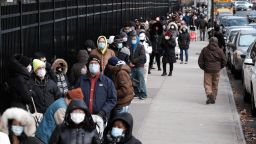This is the weekly edition of CNN’s coronavirus newsletter. Look out for your roundup every Wednesday. If you haven’t subscribed yet, sign up here.
If you test positive for Covid-19, you’ll be advised to isolate for anywhere from five days to two weeks. It all depends on where you live.
The United States and the United Kingdom have slashed their recommended self-isolation periods for asymptomatic people – and more countries may soon follow suit, as the highly transmissible Omicron variant threatens to keep hospital staff and other key workers at home.
In the US, people can now leave isolation if they don’t have symptoms after five days, followed by five days in which they should wear a mask around others. Last week, the UK cut the period to seven days for people who produce two consecutive negative lateral flow tests.
It comes amid record-setting case figures in both nations, and marks the first time since Omicron emerged that major countries have diverged from the World Health Organization’s recommended 10-day isolation period.
But most countries still follow the 10-day marker, while others, such as Germany, require up to 14 days in isolation. The disparities have led some to wonder exactly when, and how long, people are infectious with the Omicron variant.
The moves were made amid worries over the availability of key workers. “If you are asymptomatic and you are infected, we want to get people back to their jobs – particularly those with essential jobs – to keep our society running smoothly,” Dr. Anthony Fauci, director of the National Institute of Allergy and Infectious Diseases, told CNN this week.
But there is some emerging data behind the changes as well. The Centers for Disease Control and Prevention (CDC) said their decision was “motivated by science demonstrating that the majority of SARS-CoV-2 transmission occurs early in the course of illness, generally in the 1-2 days prior to onset of symptoms and the 2-3 days after.”
An early CDC study, released on Tuesday, examined an Omicron cluster in Nebraska and found that the time between exposure and infection – known as the incubation period – may be around three days. That’s shorter than the Delta strain, which studies estimate has a four-day incubation period.
A similar study of a Christmas party in Norway in which dozens became infected found comparable results.
“There is accumulating evidence, for vaccinated people, that if we are asymptomatic we are very unlikely to be infectious after about five to seven days,” Brown University’s Associate Dean of Public Health Dr. Megan Ranney told CNN on Tuesday.
Emerging evidence that Omicron may be less severe than Delta likely played a role in the moves too.
But the new guidelines have still prompted some debate in the medical community, with experts yet to fully understand Omicron.
“For the unvaccinated, the data doesn’t really back up that you become non-infectious after five days,” Ranney said. “I’m quite worried about these new recommendations.”
She suggested having different guidance for unvaccinated people until more data comes in – which could also have the “added boost” of encouraging people to take up the vaccine if they haven’t already.
Erin Bromage, a biology professor at UMass Dartmouth, added on CNN Wednesday that there is “absolutely no data that I am aware of” to support the switch in guidance.
He added that people can still test positive on antigen tests up to seven or eight days after their initial test, even if they don’t have symptoms. Unlike the UK, where antigen tests are more plentiful, the US guidance is not dependent on getting a negative result.
Omicron is nonetheless tearing through workforces in several countries, and it’s likely more nations will shorten their isolation periods in the new year if the burden on hospitals grows. “With the sheer volume of new cases … one of the things we want to be careful of is that we don’t have so many people out,” Fauci said.
YOU ASKED. WE ANSWERED.
Three preprint papers released last week revealed some early good news about the severity of the Omicron variant.
The studies – one from England, another from Scotland and a third from South Africa – suggested that Omicron is associated with a lower risk of hospitalization than the Delta variant. The degree to which that risk is decreased ranged from between 40% to 80% across the studies.
That research included preliminary data, and the papers haven’t yet been published in a peer-reviewed journal. But they add to the growing evidence that the new strain, while highly transmissible, may be less severe.
Nonetheless, a lower risk of hospitalization could easily be offset by the higher number of concurrent infections that Omicron is causing in several countries. That’s why experts are urging caution – and encouraging anyone who hasn’t taken up the vaccine or booster to do so before Omicron takes hold.
Send your questions here. Are you a health care worker fighting Covid-19? Message us on WhatsApp about the challenges you’re facing: +1 347-322-0415.
READS OF THE WEEK
How to tell if it’s Covid, the flu or a cold
Do you have a sore throat, a runny nose and muscle aches? It could be a common cold, a case of the flu – or Covid-19.
The illnesses all share similar symptoms, sometimes making it hard to distinguish which is putting you under the weather.
Case rates of Covid-19 have been on the rise as the Omicron variant has spread, but hospitalization numbers appear to be staying relatively low. For vaccinated people, evidence suggests that infection with this variant seems less likely to be severe, epidemiologist and former Detroit Health Department executive director, Dr. Abdul El-Sayed, former director of the Detroit Health Department, told CNN.
“The important thing to remember is a vaccine is like giving a ‘be on the lookout’ call to your immune system. So its capacity to identify, target and destroy viruses is so much higher every time we take another boost of the vaccine,” El-Sayed said.
“It makes sense that the symptoms you would experience are milder if you have been vaccinated.” That does not mean, however, that infections shouldn’t be taken seriously, he added, especially when considering the risk of overwhelming health care systems.
Many Latin American countries now have higher vaccination rates than Europe and North America
Many countries in Latin America were hit with soaring Covid-19 death rates early in the pandemic, as coronavirus raged throughout the region.
The tide is turning in many Latin American nations today, where vaccination rates are outpacing countries in Europe and North America and helping drive down deaths, Tim Lister writes.
The vaccine rollout was slow at the start, with just getting the vaccines in hand a major issue. Just six months ago, Latin America and the Caribbean were reporting just under half of all Covid-19 related deaths worldwide.
Now, the region accounts for about 10% of global Covid-19 related deaths, according to the latest data from Johns Hopkins University. That’s due to the accelerated delivery of European, American, Chinese and homegrown vaccines that a number of Latin American nations have received in the second half of this year, according to Pan American Health Organization (PAHO) data.
One reason for those successful vaccination campaigns can be chalked up to history: Many countries in Latin America have long-standing and trusted national inoculation drives against other diseases, such as polio.
Omicron sparks a Christmas travel nightmare
Several thousand flights have been canceled this week as Covid cases surge across the globe.
More than 2,000 trips were canceled on Wednesday, following a spate of scuppered trips during the holiday period. Of more than 2,800 canceled flights on Monday, around 1,000 were within, into or out of the US, according to FlightAware.
Almost 11,000 flights are delayed. Globally, airlines canceled more than 6,000 flights on Christmas Eve, Christmas and the day after Christmas. In the US, more than 1,200 flights were canceled and more than 5,000 were delayed on Sunday alone as staff and crew call out sick.
The cancellations come at the busiest time of year for air travel. The US Transportation Security Administration (TSA) said it screened millions of people each day over the holiday weekend, peaking at 2.19 million travelers on Thursday, December 23.
On Wednesday, more people passed through TSA checkpoints than on the same day in 2019.
TOP TIP
It’s time to upgrade your mask
As the Omicron coronavirus variant continues to spread, some experts say it’s past time to reconsider your face mask options – especially if you’re still wearing the cloth variety.
“Cloth masks are little more than facial decorations. There’s no place for them in light of Omicron,” said CNN Medical Analyst Dr. Leana Wen, an emergency physician and visiting professor of health policy and management at the George Washington University Milken Institute School of Public Health.
Ideally, in crowded places, “you should be wearing a KN95 or N95 mask,” which can be as inexpensive as a few dollars each, Wen added.
By having a better fit and certain materials – such as polypropylene fibers – acting as both mechanical and electrostatic barriers, these masks better prevent tiny particles from getting into your nose or mouth and must be fitted to your face to function properly.


















